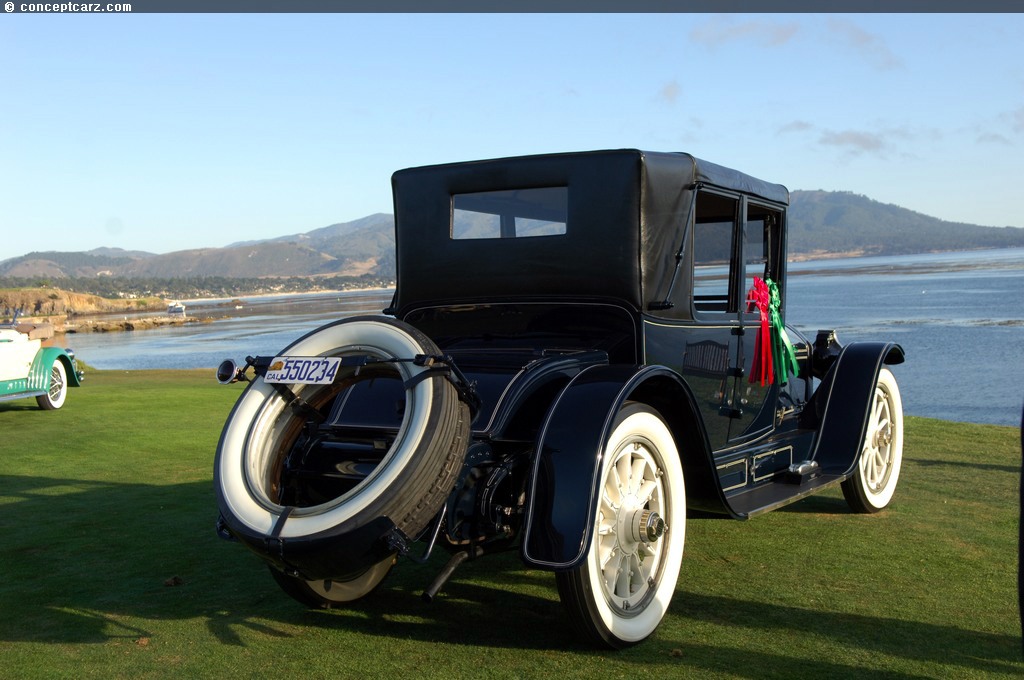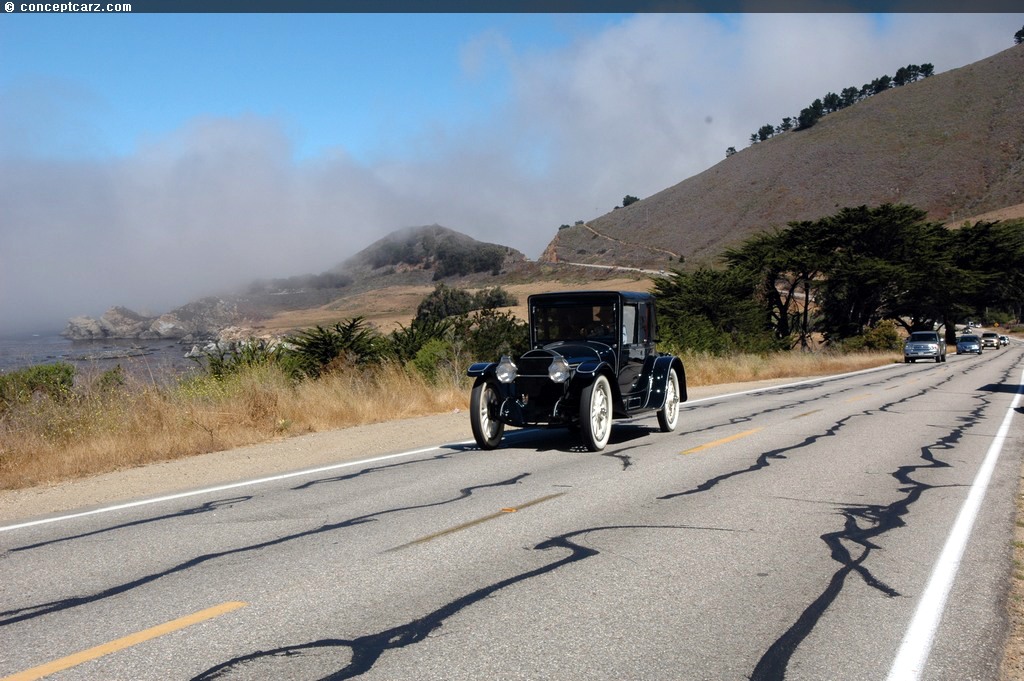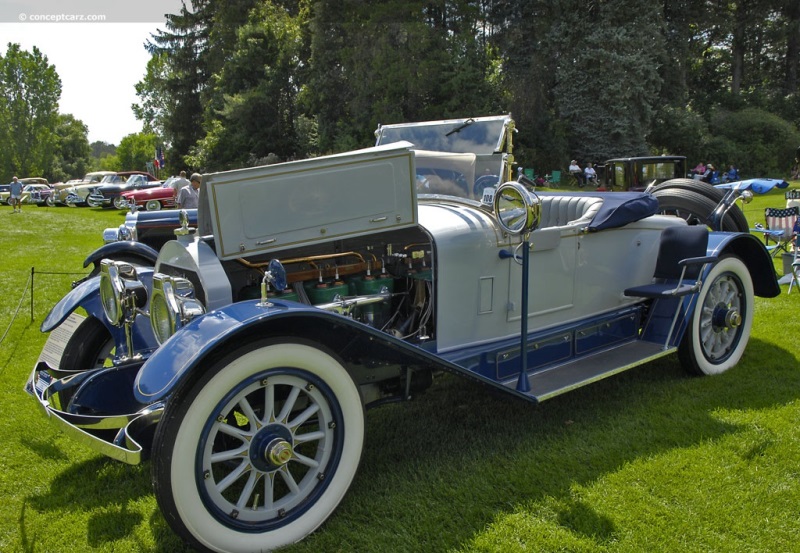Locomobile of Bridgeport, Connecticut, began in 1899 when magazine publisher John Brisben Walker and Amzi Lorenzo Barber, the 'Asphalt King,' took over the steam car business of F.E. and F.O. Stanley. Their $600 steam car was named 'Locomobile' and quickly grew in popularity, with approximately 2,200 cars built in 1901. By 1903, its popularity faded as sales were overtaken by the curved-dash Oldsmobile. 
Chauffeur Coupe by Healey & Co
Chassis #: 11929
Engine #: 9796
View info and history
Auction entries : 1Locomobile hired engineer Andrew L. Riker to design a gasoline-powered, four-cylinder, front-engine model wearing lightweight stamped aluminum bodywork. In this guise, fully equipped, it sold for $4,000. It was briefly joined by a twin-cylinder model, but by 1905, it was the sole model and offered in four sizes.
Locomobile's steam car had been a very popular 'volume' seller, but their gasoline took on a different persona and catered to the influential and affluent members of society. In 1905, the most expensive Locomobile sold for $7,500, making it one of the most expensive vehicles available. The Locomobile 48-hp Type M was introduced in 1911 and would become the company's most significant and long-lived model. Power was sourced from an iron T-head six-cylinder unit with a 429 cubic-inch displacement size and a single Ball and Ball Updraft carburetor. The cylinders were cast in pairs and bolted to a bronze crankcase, which contained a drop-forged alloy steel crankshaft that was both statically and dynamically balanced and rode in seven main bearings. The '48' grew to 525 cubic inches and 142 inches, and by 1914, the four-cylinder cars had been dropped and a smaller six became the 'entry-level' Locomobile. While all of Locomobile's competitors used a three-speed gearbox, the Model 48 utilized a four-speed transmission. Stopping power was provided by mechanical drum brakes on the rear wheels. The quality and craftsmanship could be seen throughout the vehicle, and no shortcuts or inferior components were used in its construction. The chassis members were pressed from chrome-nickel steel, then heat-treated and hot-riveted together, and suspended by chrome-nickel-tungsten steel leaf springs. The front used a solid axle, and the back had a live axle. Semi-elliptical leaf springs were in the front, while the rear used three-quarter elliptical leaf springs.During the early 1920s, Locomobile, like most other manufacturers, was affected by both the post-World War I recession and the infusion of military trucks which came on the market after the war, decimating sales of its Riker truck line. Locomobile fell into the hands of Hare's Motors, and when they collapsed, it was acquired by Billy Durant. Locomobile entered receivership in 1929, the victim of inspired mismanagement and manipulation, bringing to a close the saga of one of America's earliest and best automobiles.
Chauffeur Coupe by Healey & Co
Chassis #: 11929
Engine #: 9796
View info and history
Auction entries : 1The Locomobile Model 48 was produced from 1911 through 1926 and changed little during that time, and was one of the few luxury automobiles whose production run spanned the brass, nickel, and chrome eras. Since the company prided itself on quality over quantity, just four cars were assembled per day, with prices far exceeding the company's primary competitors at Packard, Pierce-Arrow, and Peerless. They were expensive, solid, conservative, and durable.
by Daniel Vaughan | Oct 2021

Chauffeur Coupe by Healey & Co
Chassis #: 11929
Engine #: 9796
View info and history
Auction entries : 1
Locomobile's steam car had been a very popular 'volume' seller, but their gasoline took on a different persona and catered to the influential and affluent members of society. In 1905, the most expensive Locomobile sold for $7,500, making it one of the most expensive vehicles available. The Locomobile 48-hp Type M was introduced in 1911 and would become the company's most significant and long-lived model. Power was sourced from an iron T-head six-cylinder unit with a 429 cubic-inch displacement size and a single Ball and Ball Updraft carburetor. The cylinders were cast in pairs and bolted to a bronze crankcase, which contained a drop-forged alloy steel crankshaft that was both statically and dynamically balanced and rode in seven main bearings. The '48' grew to 525 cubic inches and 142 inches, and by 1914, the four-cylinder cars had been dropped and a smaller six became the 'entry-level' Locomobile. While all of Locomobile's competitors used a three-speed gearbox, the Model 48 utilized a four-speed transmission. Stopping power was provided by mechanical drum brakes on the rear wheels. The quality and craftsmanship could be seen throughout the vehicle, and no shortcuts or inferior components were used in its construction. The chassis members were pressed from chrome-nickel steel, then heat-treated and hot-riveted together, and suspended by chrome-nickel-tungsten steel leaf springs. The front used a solid axle, and the back had a live axle. Semi-elliptical leaf springs were in the front, while the rear used three-quarter elliptical leaf springs.During the early 1920s, Locomobile, like most other manufacturers, was affected by both the post-World War I recession and the infusion of military trucks which came on the market after the war, decimating sales of its Riker truck line. Locomobile fell into the hands of Hare's Motors, and when they collapsed, it was acquired by Billy Durant. Locomobile entered receivership in 1929, the victim of inspired mismanagement and manipulation, bringing to a close the saga of one of America's earliest and best automobiles.

Chauffeur Coupe by Healey & Co
Chassis #: 11929
Engine #: 9796
View info and history
Auction entries : 1
by Daniel Vaughan | Oct 2021
Related Reading : Locomobile Model 48 History
The name 48 was used by the Locomobile Company to signify their six-cylinder engines that were originally rated at 48 horsepower. The first Model 48 was introduced in 1911 and remained in production until 1924. At this point, horsepower had skyrocketed to just over 100. When it was first introduced, it was a marvel both aesthetically and mechanically. By the mid-1920s, it had begun to show its age.....
Continue Reading >>
Continue Reading >>
Related Reading : Locomobile Model 48 History
Owned by elite members of upper East Coast aristocracy like Vanderbilt, Wanamaker, Melon, Gould, and Governor Cox of Massachusetts, and prestigious members of the West like Tom Mix, Charlie Chaplin, and Cecil B. DeMille, the Locomobile Model 48 was one of the most expensive and elegant automobiles ever manufactured in the United States. Weighing 3 tons, the six-cylinder Model 48 came arrived on the....
Continue Reading >>
Continue Reading >>
Locomobile
Similar Vehicles
1917 Locomobile Model 48 Vehicle Profiles
Recent Vehicle Additions
Performance and Specification Comparison
Price Comparison
Model 48 Specification Comparison by Year
Year
Production
Wheelbase
Engine
Prices
Related Automotive News

Brass Era Thomases Fly Past Estimates At Bonhams' White Glove Sale
Two Generations Collection 100 Sold in Newport
A pair of All-American Brass Era Thomas motor cars flew past their estimates, together achieving more than a million dollars, in Bonhams white glove Two Generations Collection...

Rare Barnfind Mercedes-Benz and Concours-Restorations Parade at Bonhams Scottsdale Auction
A rare and special barnfind Mercedes-Benz – surely one of the last unrestored 300S Roadsters – will line up with a parade of concours-standard restorations at The Scottsdale Auction, Bonhams motor cars season-opener staged at the Westin Kierland Resort,...

Gooding & Company Looks Toward Pebble Beach with Stunning Selection of Historic Prewar Classics
Highlights include a top-of-the-line 1930 Duesenberg Model J Disappearing-Top Convertible Coupe, a Grand Prix-winning 1929 Bugatti Type 35B, a well-documented 1914 Stutz 4E Bearcat, and an opulent 1910 Rolls-Royce 4050 HP Silver Ghost Pullman Limousine.
As...

Cobble Beach Concours : Best of Show
The 7th annual Cobble Beach Concours dElegance was held near Owen Sound in the Township of Georgian Bluffs at the Cobble Beach Waterfront Golf Resort Community in Canada. It is a luxury four-season resort nestled on 574 acres with an 18 hole links...

Amelia Island Concours dElegance Announces Special Classes For 2018
The 23rd annual Amelia Island Concours dElegance will host eleven special classes in 2018.
HUNTING CARS - Among the rarest of the custom coachwork cars none are more specialized, exotic and hardworking than the cars created especially...


































